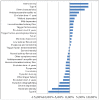Alpha lipoic acid efficacy in burning mouth syndrome. A controlled clinical trial
- PMID: 26034927
- PMCID: PMC4523256
- DOI: 10.4317/medoral.20410
Alpha lipoic acid efficacy in burning mouth syndrome. A controlled clinical trial
Abstract
Background: A double-blind placebo-controlled trial was conducted in order to evaluate the efficacy of alpha lipoic acid (ALA) and determine the statistical significance of the outcome variables. Burning mouth syndrome (BMS) is defined as an oral burning sensation in the absence of clinical signs which could justify the syndrome. Recent studies suggest the existence of neurological factors as a possible cause of the disease.
Material and methods: 60 patients with BMS, in two groups: case group with 600 mg/day and placebo as control group; with follow up of 2 months.
Results: 64% of ALA patients reported some level of improvement, with a level of maintenance of 68.75% one month after treatment. 27.6% of the placebo group also demonstrated some reduction in BMS symptoms.
Conclusions: Long-term evolution and the intensity of symptoms are variables that reduce the probability of improvement with ALA treatment.
Conflict of interest statement
Figures
References
-
- Merskey II , Bogduk N . Classification of Headache disorders. 2nd edition. New-York: Seattle: International Association for the Study of Pain ; 2004. pp. 9–205.
-
- Rhodus NL, Carlson CR, Miller CS. Burning mouth (syndrome) disorder. Quintessence Int. 2003;34:587–93. - PubMed
-
- Lamey PJ, Lewis MA. Oral medicine in practice: burning mouth syndrome. Br Dent J. 1989;167:197–200. - PubMed
-
- Minguez-Sanz MP, Salort-Llorca C, Silvestre-Donat FJ. Etiology of burning mouth syndrome: a review and update. Med Oral Patol Oral Cir Bucal. 2011;16:e144–8. - PubMed
-
- Tourne LP, Fricton JR. Burning mouth syndrome. Critical review and proposed clinical management. Oral Surg Oral Med Oral Pathol. 1992;74:158–67. - PubMed
Publication types
MeSH terms
Substances
LinkOut - more resources
Full Text Sources
Other Literature Sources
Medical


